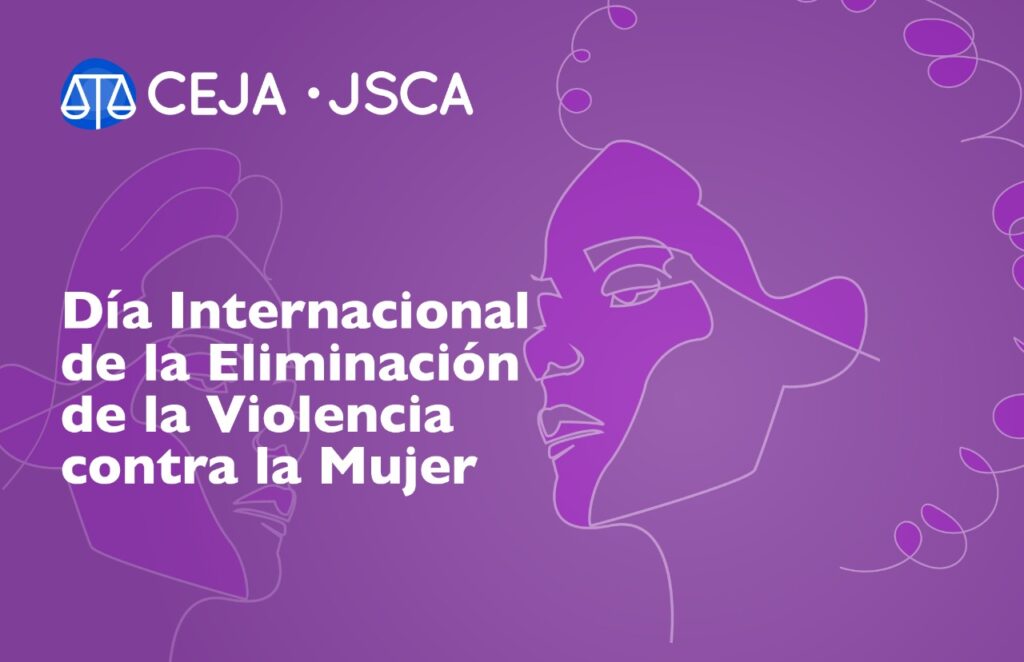
Today, November 25, International Day for the Elimination of Violence against Women, the Justice Studies Center of the Americas (JSCA) reiterates the need to incorporate the gender perspective into justice systems as part of States’ international obligations to prevent, sanction and eradicate violence.
According to the Declaration on the Elimination of Violence against Women, violence against women is:
a manifestation of historically unequal power relations between men and women, which have led to domination over and discrimination against women by men and to the prevention of the full advancement of women, and that violence against women is one of the crucial social mechanisms by which women are forced into a subordinate position compared with men (General Assembly, 1993, Preamble).
At the regional level, the Inter-American Convention to Prevent, Sanction and Eradicate Violence against Women (Belém do Pará Convention) recognizes violence as an expression of historically unequal relationships between men and women and states that its elimination is an indispensable requirement for achieving equality.
In this sense, we should highlight the express consideration of both the Belém do Pará Convention and the Declaration in regard to considering gender violence to be a violation of human rights in that it fully or partially limits the recognition, enjoyment and exercise of those rights and freedoms for women (Organization of American States, 1994, Preamble).
The discussion around unequal power relationships in function of gender becomes even more complex when we adopt a non-binary perspective and recognize identities that do not satisfy heteronormativity and/or cisnormativity and are marginalized, made invisible and often subject to violence based on their sexual orientation, identity and/or gender expression. The IACHR has stated that violence against LGBTQ+ individuals is based on the perpetrator’s desire to ‘punish’ said identifies, expressions, behaviors or bodies that differ from traditional gender norms and roles or that go against the binary system of man/woman. (IACHR, 2015 a, paragraph 25).
As such, both women and LGBTQ+ individuals are in a subordinate position based on their identity and are subject to gender violence. Said violence cannot be understood as isolated acts. Rather, it must be interpreted as expressions within permissive social contexts that reproduce the structures of dominant inequality.
As we have said, this type of violence requires a context that reinforces or allows prejudices that are used to justify that violence. In that sense, the social beliefs that hold that one group of people is superior to another can constitute a form of structural violence (United Nations, 2011, paragraph 28).
The IACHR has stated that the source of discriminatory treatment is presumably based on the group, which means that eradicating the gender hierarchy requires a structural intervention focused on changing basic social spaces and institutions such as justice, politics, the family and the market (IACHR, 2007, paragraph 77).
Recognizing historic inequality based on gender involves access to justice in the sense that the elimination of judicial stereotypes in justice systems is an essential measure to ensure equality and justice for victims and survivors (CEDAW, 2015, paragraph 28). The Court also has referred to the prejudicial effect of stereotypes in the area of justice in that it has cataloged them as a cause and consequence of gender violence (IACHR, 2014).
As such, the incorporation of the gender perspective as an institutional policy within justice systems is an essential requirement for moving towards the elimination of socio-cultural barriers linked to gender. These must be understood as a tool for identifying specific and differentiated ways in which gender-based violence operates. This work must also incorporate an intersectional analysis in order to understand the specific ways violence impacts victims, considering their age, ethnicity, social condition and other factors (Munévar-Munévar & Mena-Ortiz, 2009).
In order to elucidate the progress made on incorporating the gender perspective into judiciaries in the region, JSCA has published an initial study on this topic in the context of its gender policy. The goal is to identify Latin American judiciaries’ gender units and the work that they have undertaken to incorporate a gender perspective into the institution’s culture and work.
In honor of International Day for the Elimination of Violence against Women, JSCA is presenting the initial findings of that study, and invites justice systems, civil society organizations and States to consolidate the progress made and reinforce efforts to ensure access to justice for victims of gender violence.
You can now download the publication Gender Judicial Offices in Latin America: Advances and Challenges HERE
